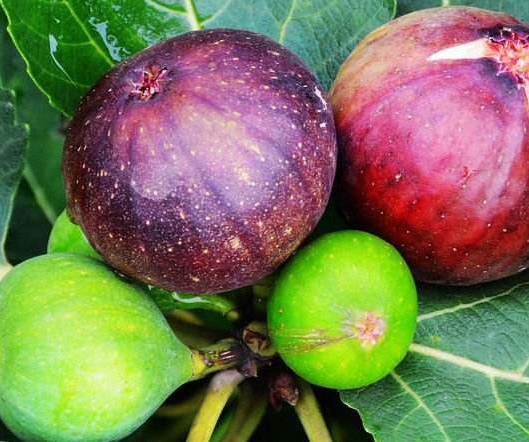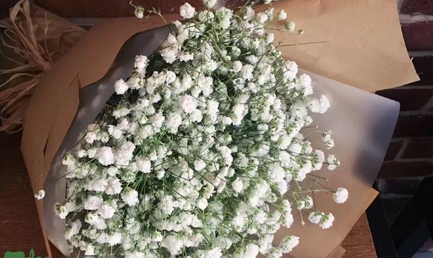How to plant figs the cause of fruit drop and how to do it
When it comes to figs, many people like to breed figs. Figs can be cultivated as potted plants. Let's see how figs are planted. The reason for the fall of figs and what to do:

How to grow figs:
1. The soil should be weakly alkaline.
2. When a new branch grows to four or five leaves, it will pick the heart, and the branch will also pick the heart with five leaves. It is enough for one new branch to leave two branches, and the rest will be wiped out.
3. It was only after the result that the top dressing began.
4. There is a lot of water and fertilizer before the fruit is ripe. During the fruit growth and development period, 0.2% potassium dihydrogen phosphate and other foliar fertilizer can be sprayed on the leaves to increase the number of fruits and increase the yield.
5. If figs are to be thinned, don't be reluctant to pick secondary shoots at the same time.
6. when the fruit is ripe, and every time a fruit is removed, the leaves adjacent to it should be removed, so that other fruits can continue to grow big and sweet.
7. Watering
Figs are not resistant to waterlogging and drought, and the principle of "dry and wet" is mastered in daily watering. ("dry and wet" is a common term in flower planting, which means watering thoroughly once, and then watering the second time when the soil is slightly dry. its function is to prevent diseases and insect pests caused by rotten roots and moisture caused by too much watering.
Figs can be properly watered in spring and autumn to keep the soil moist. During the summer fruit expansion period, figs should be watered one or two times a day, and watering times should be increased appropriately in dry season.
8. Fertilization
The ratio of calcium: nitrogen: potassium: phosphorus = 1.43, 1.00, 0.90, 0.30. The ratio of nitrogen, phosphorus and potassium should be 1.0, 0.5 and 0.7 for young trees and 1.00, 0.75 and 1.00 for adult trees. Base fertilizer, organic fertilizer is the best, generally applied in the dormant period after defoliation, 1kg yield is required to apply organic fertilizer 1. 0-1.5kg. Make a trench or annular ditch at the bottom of the branch. On the basis of sufficient base fertilizer, topdressing (soil application or foliar spraying) should be applied 5-6 times a year. Nitrogen fertilizer is the main fertilizer in the early growth stage, phosphorus and potassium fertilizer is the main fertilizer in the later fruit ripening period, and calcium fertilizer is supplemented (either soil application or leaf spraying). Soil topdressing should be combined with watering, ditching and topdressing, covering soil and watering, and surface dressing is not recommended. Figs like fertilizer, focus on three times: the first time is early spring branch fertilizer, mainly nitrogen fertilizer; when it begins to sprout, sprinkle a large amount of nitrogen fertilizer to the ground, immediately pour water to flush nitrogen fertilizer into the soil, and then apply nitrogen fertilizer once a month, a total of three times until the beginning of fruit. The second time is to protect fruit fertilizer, the time is in the first batch of fruit expansion period, the combined application of nitrogen and phosphorus is better; dig 3-4 deep 30~40cm holes in the tree trunk 50cm to apply. The third time is overwintering fertilizer, applied before winter, mainly potash fertilizer, the base can be covered with plant ash.
Moisture must be replenished in time according to soil moisture. The main water requirements of figs are germination period, shoot speed period and fruit growth and development period. In addition to the traditional furrow irrigation and hole irrigation, drip irrigation and sprinkler irrigation can be carried out under certain conditions. Fig should not be irrigated too much at one time, especially during the harvest period of fruit ripening, to avoid excessive changes in soil dry humidity, we should always maintain stable and appropriate soil moisture, so as not to lead to the increase of fruit cracking. In addition, figs have strong drought resistance and weak waterlogging tolerance, so we should pay special attention to timely drainage in the plum rain season and hoe and loosen the soil in time after rain.
10. Pruning and plastic surgery
The open-field cultivation of figs in the eastern United States is extensive, and the adult trees do not need special management. The branches and leaves grow vigorously and can naturally form a large crown, but the fruit is late and less. Often the autumn fruit is not ripe and the weather has turned cool, yield but not harvest. Therefore, it is necessary to pick the heart in time, do not make it continue to extend, in order to facilitate the early ripening and secondary fruit ripening of the lower part of the branch, and the time, quantity and retention of the fruit should be moderate, which should be beneficial not only to the fruit of the current year, but also to the growth and fruit of the tree in the coming year. Coring can inhibit the growth of new shoots, reduce the length of branches, promote sprouting branches, and increase the branches at the base of big branches or backbone branches. Therefore, picking the heart of the new shoots in the growing period can promote the growth of secondary branches, which is conducive to the expansion of the crown and the multi-use of young trees. In addition, in order to promote the growth, maturity and fullness of new shoots in the same year, coring can be done during the slow growth period of new shoots, which can promote flower bud differentiation, facilitate early ripening of fruit, and increase single fruit weight. The heart-picking period is generally from mid-July to early August. And cut off the sterile branches, select the lower leaves in time when the fruit is ripe, increase sunlight and concentrate nutrients on figs. Figs have the characteristics of new branches bearing fruit, which begin to bear fruit as soon as the new branches are drilled out of the ground, growing one leaf and one fruit to the top. Therefore, the new branches should generally be retained in the current year, and the unnecessary branches should be cut off later. It is suitable for senile branches to be renewed every five years, during the period from late autumn to early spring. There are buds of summer fruit at the top of the branches in winter, so be careful not to cut them off as far as possible, so as not to affect the yield of summer fruit. Sprouting removes lateral buds from branches during the growing season. The main purpose of sprouting is to reduce the consumption of nutrients and prevent the branches from sprouting buds from growing in disadvantageous positions and affecting the light of the crown. The period of sprouting should be early, which can reduce the consumption of storage nutrients, and the trees with medium and weak tree potential should wipe buds as far as possible, so as to concentrate the supply of storage nutrients to retain buds and produce strong branches. For strong trees, the germination period is a little later and often uneven, and the period of erasing buds can be postponed appropriately. After a long period of time, the buds that are too strong are removed and the buds with uniform growth and medium strength are selected to grow. # p# subtitle # e #
The reason for the fall of figs and what to do:
1. Water
Figs have large leaves and exuberant water evaporation, especially in the rapid growth period of new shoots and fruits. Therefore, the soil is too dry, which will affect the plant development, make the flesh thicker, the fruit smaller and the quality worse. It may even make the fruit dry and fall off prematurely before ripening.
II. Diseases and insect pests
1. Nematodes: nematodes are parasitic on the roots of figs, harming the young root tissue of the root system, making it nodular, causing rot, swelling, and root shrinkage, leading to plant dwarfism, yellowing of leaves, early fruit drop and other symptoms.
two。 Longicorn beetles: longicorn beetles are harmful to longicorn beetles. Longicorn beetles are now eaten vertically and horizontally under the cortex, and then eat into the xylem, deep and large tree trunks. The weak tree body of the injured plant leads to fallen leaves and fruit, which is easy to be broken by the wind, and in serious cases, it may even lead to plant death.
3. Harmful mites: adult mites and nymph mites gather on the back of the leaves, absorb leaf juice, make the leaves lose green, turn yellow and white, and cause fallen leaves. After the fruit is killed, the pericarp is rough, and the fruit shrinks and falls due to expansion difficulties.
III. Fertilizer (lack of element)
1. Nitrogen deficiency: lack of nitrogen, the number of inflorescence differentiation will be reduced, the early fruit type is still normal, but the fruit Hengjing becomes smaller, the ripening period will be earlier and the quality will be good. However, due to the transfer of many nutrients in nitrogen-deficient leaves to the fruit, the leaves faded obviously, and the fruit drop in the upper part of the branch was serious. After topdressing, the branch growth will recover, but the fruit is easy to brown and drop.
two。 Potassium deficiency: serious potassium deficiency, there will be leaf burning, branches stop growing, often have ladyshaped fruit, potassium deficiency will lead to poor root growth, blackening, peeling and decay, and then lead to fruit drop.
3. Magnesium deficiency: magnesium deficiency first appeared yellowing symptoms in the exuberant growing leaves, but less in the upper and lower parts. With the aggravation of the symptoms, all the leaves except petioles showed yellowing, large brown spots appeared, symptoms intensified, root growth was inhibited, and early fruit drop appeared.
4. Calcium deficiency: figs have a great demand for calcium. When the figs are deficient in calcium, the uppermost unfolded leaves suddenly albino and appear brown spots, resulting in deciduous leaves, the lower leaves grow normally, the branches become dark brown and atrophy, and when serious, the root elongation is obviously hindered. Easy to rot and have a particularly strong organic acid smell, the fruit blackens and falls off early.
5. Iron deficiency: when it occurs, the new shoots grow slowly, and the new buds bleach and die. It occurs in the early stage of growth, and all the young fruits are albino and fall off. If the symptoms appear in the later stage of growth, the fruits can still mature normally in the early and middle stages.
This is the end of the introduction on the methods of planting figs and the causes and treatment of falling fruit. Plant a potted fig as soon as possible.
Methods to prevent figs from falling
Pay attention to rational fertilization
Reasonable fertilization can reduce the drop of figs to some extent. The branches of figs grow continuously, and the flowering and fruiting are carried out at the same time, so we should pay attention to rational fertilization and apply some nitrogen fertilizer to promote the growth of branches and leaves in the young period of fruit trees. As long as it can make figs grow healthily. Fruit trees that are three or four years old do not need to apply organic fertilizer, but can apply some urea before the fig fruit expands rapidly.
Pay attention to drainage
Fig is a drought-tolerant plant, its root system is very strong, but it is not resistant to waterlogging, so we must pay attention to drainage when planting fig trees. As the fig leaves are very large, so the transpiration capacity of the leaves is also very strong, so we should pay attention to providing sufficient water to the figs in summer, watering them in time during the dry season or after fertilization, and watering an appropriate amount of frozen water before winter.
Reasonable watering and reasonable drainage can make fig trees healthier and stronger and less likely to drop fruit. In addition, attention should be paid to reasonable drainage in the rainy season and when the fruit is about to ripen. Too much water will increase the weight of figs. More prone to the phenomenon of fruit drop.
Pay attention to the prevention and control of diseases and pests
Pests and diseases will weaken fig trees and affect the absorption of nutrients in fig trees. Malnourished fig trees are prone to fruit drop. Therefore, we should always observe fig trees to see if there are any pests. Once pests occur, we should deal with them immediately, use relevant pesticides, kill pests in time according to instructions, and control fig falls.
Rational spraying of auxin
When the temperature drops suddenly, the ripening time of figs will be delayed, which will cause figs to fall. In this case, we can spray the relevant auxin to promote the fig fruit to mature at a reasonable time, which can not only prevent the fig from falling, but also improve the quality of the fig fruit.
Is the fig a bad tree or an auspicious tree? how is it that the figs fall?
Figs, which is also a kind of fruit, is known to many people, so is this fig evil tree or auspicious tree? What happened to the fruit drop:
Figs are evil trees or auspicious trees:
1. Influence fengshui
In fact, in fengshui, many trees cannot be planted at home, such as willow, poplar, locust and the fig tree we are going to talk about. Fig tree wood belongs to bad wood, planted at home, then it will affect feng shui, bring bad feng shui luck, it is best not to keep it at home or in the courtyard.
2. Recruiting ghosts
Many people don't know whether figs are evil trees or auspicious trees. They keep fig trees at home. Over time, you will find that the home has become a little "dirty", this is because the fig tree is too cold, it is a kind of plant with its own shade, and it will attract ghosts if it is planted for a long time.
3. Affect health
Evil trees are very unlucky, and evil spirits will appear when planted at home. And the taller the tree is, the heavier it will be. This kind of tree will turn around the fortune of the family and damage the health of the family. In particular, it will make the child's body very weak because of it.
What happens when figs fall:
The main results are as follows: 1. The differentiation number of nitrogen-deficient inflorescences will be reduced, and the early fruit type will be normal, but the fruit will become smaller, the ripening period will be earlier and the quality will be good. However, due to the transfer of many nutrients in nitrogen-deficient leaves to the fruit, the leaves faded obviously, and the fruit drop in the upper part of the branch was serious. After topdressing, the branch growth will recover, but the fruit is easy to brown and drop.
2. Serious potassium deficiency will lead to leaf burning, branches stop growing, and ladyshaped fruits often appear. Potassium deficiency will lead to poor root growth, blackening, peeling and decay, and then lead to fruit drop.
3. Magnesium deficiency first appeared yellowing symptoms on the exuberant leaves. With the aggravation of the symptoms, all the leaves except the petiole showed yellowing and large brown spots, the symptoms intensified, the root growth was inhibited, and the fruit fell ahead of time.
4. Figs have a great demand for calcium. When the figs are deficient in calcium, the uppermost unfolded leaves suddenly whiten and appear brown spots, resulting in fallen leaves, the lower leaves grow normally, the branches become dark brown and atrophy, and in serious cases, the root elongation is obviously hindered. Easy to rot and have a particularly strong organic acid smell, the fruit blackens and falls off early.
This is the end of the introduction to figs. Now you know why the figs are falling.
- Prev

How can roses be raised in water for how many days
Roses, which are the most common in love, are generally given by boys to girls, and this rose is usually fresh flowers. Let's see how roses are raised in water. How many days can roses grow? how do roses grow in water: 1. Break vitamin C into small pieces, crush them, put them in water, or add a little sugar to the water.
- Next

How do you keep the stars in a vase? do you want to raise water when you buy them back?
When it comes to this star in the sky, many people like it very much. this star is very auspicious. this star is so likable, how to keep it in a vase?
Related
- Fuxing push coffee new agricultural production and marketing class: lack of small-scale processing plants
- Jujube rice field leisure farm deep ploughing Yilan for five years to create a space for organic food and play
- Nongyu Farm-A trial of organic papaya for brave women with advanced technology
- Four points for attention in the prevention and control of diseases and insect pests of edible fungi
- How to add nutrient solution to Edible Fungi
- Is there any good way to control edible fungus mites?
- Open Inoculation Technology of Edible Fungi
- Is there any clever way to use fertilizer for edible fungus in winter?
- What agents are used to kill the pathogens of edible fungi in the mushroom shed?
- Rapid drying of Edible Fungi

